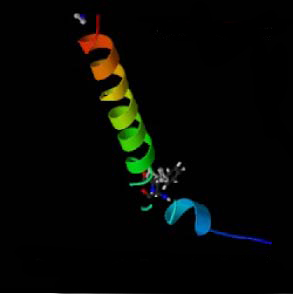| Name
|
Astressin
|
| Other Name
|
[D-Phe12, Nle21,38,,Glu30, Lys33]-Corticotropin Releasing Factor fragment 12-41
|
| Sequence (Single letter abbreviations)
|
|
| Sequence(Three letter abbreviations)
|
{d-PHE}{HIS}{LEU}{LEU}{ARG}{GLU}{VAL}{LEU}{GLU}{NLE}{ALA}{ARG}{ALA}{GLU}{GLN}{LEU}{ALA}{GLN}{GLU}{ALA}{HIS}{LYS}{ASN}{ARG}{LYS}{LEU}{NLE}{GLU}{ILE}{ILE}-NH2
|
| C-port
|
NH2
|
| Chemical bridge
|
Peptide beta bond: Glu30-Lys33
|
| Basic description
|
Astressin is an amino-terminal truncated analog of CRF that retains affinity binding to the extracellular domain of the receptor and is believed to act as a neutral competitive antagonist of receptor activation.
|
| The molecular weight
|
3563.160
|
| Chemical formula
|
C161H251N49O42
|
| The purity
|
> 95%
|
| Storage conditions
|
Store at -20°C. Keep tightly closed.
|
| Documents
|

|
| Figures
|

|
| Reference
|
Klausner AP, et al. The role of corticotropin releasing factor and its antagonist, astressin, on micturition in the rat. Auton Neurosci. Dec 2005; 123(1-2): 26-35.
SI Khan., etc. Feeding response following central administration of chicken vasoactive intestinal peptide in chicks. Gen Comp Endocrinol. 2013 Jan;S0016-6480(13):00009-9.
|
